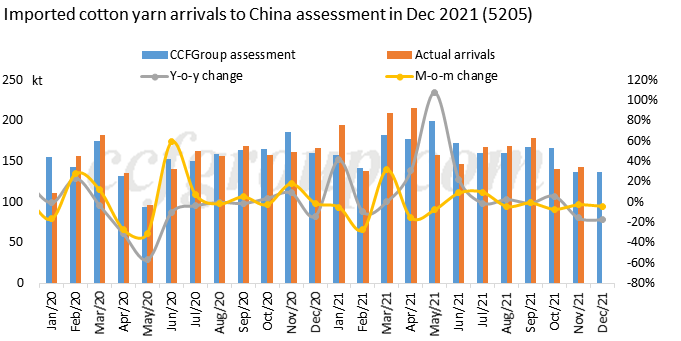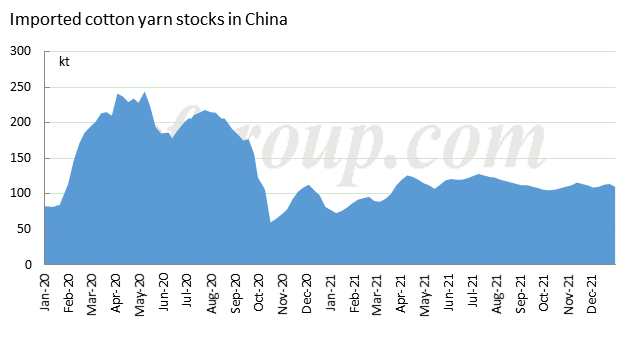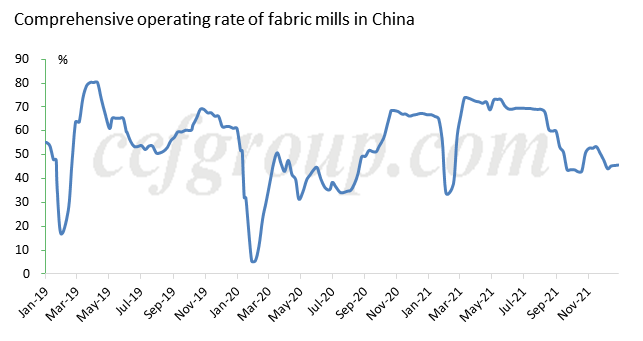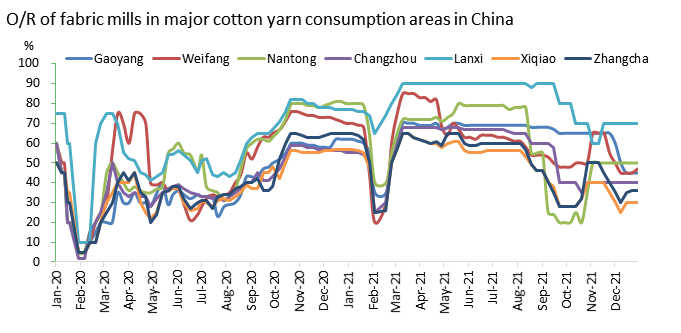1. Imported cotton yarn arrivals to China assessment

Cotton yarn imports of China in Nov reached 143kt, down 11.6% on the year and up 20.2% on the month. It amounted to about 1,862kt cumulatively in Jan-Nov 2021, up 14.2% year on year, and up 0.8% from the same period of 2019. The imports in the fourth quarter declined obviously. Since Chinese traders purchased intensively in Sep and the first half of Oct, they have not purchased at large amounts, so the arrivals in Nov-Dec were limited. But there were still supports from foreign markets like reflow of overseas investment, financing demand and dependency of end-user on products. By comparison, the imports in Dec is initially assessed at 137kt, down about 17.5% on the year and 4.3% on the month and it is expected to amount to about two million tons in the whole 2021, up 11.3%.
According to export data of foreign markets in Nov, cotton yarn exports of Vietnam continued to decrease on the month. During the second half of Nov to the first half of Dec, Vietnam’s cotton yarn exports reduced about 3.7% on the month, so the part to China is expected to be flat with last month. Cotton yarn exports of Pakistan in Nov fell by 3.3% on the month, and that to China may inch down in Dec. India’s cotton yarn exports in Nov also showed downtrend according to local mills as its export data for Nov has not been published, so the Dec exports to China is predicted to decrease on the month. The ordering for Uzbekistani cotton yarn weakened obviously in the third and fourth quarters, so the part to China in Dec is likely to slightly improve. Based on the above assessment, Dec cotton yarn imports of China is possibly to dip from the four major exporters. It is initially estimated that cotton yarn imports of China in Nov from Vietnam is at 62kt; from Pakistan 17kt, from India 21kt, from Uzbekistan 14kt and from other regions 23kt.

2. Imported yarn stocks moved up first and then fell down.

In Dec, the stocks of imported cotton yarn in China showed an up-to-down trend. In the first half month, downstream orders were slack and with successive arrivals, the stocks of imported cotton yarn increased. In the second half month, with reduced arrivals, underselling and improvement of the demand, the stocks declined slightly. In addition, the improvement of sales was heard to benefit from downstream replenishment, increase in orders and traders’changing hands.

The operating rate of downstream weavers which use imported cotton yarn as raw materials moved down at first and then rose in Dec. In the second half month, it increased along with the improvement of orders, but only limitedly. The resurgence of COVID-19 pandemic in Shaoxing, Shangyu, Ningbo and Hangzhou of Zhejiang affected the logistics of cotton yarn. In Guangdong, it slid in the first half month and recovered somewhat later.

Forward imported cotton yarn price kept higher than spot one, which hindered the replenishment of Chinese traders. After Dec consumption, tight supply of cotton yarn was seen in some regions and varieties. Then the mills started to raise offers tentatively, but the trades did not follow up. Jan arrivals will be those ordered in late Oct and Nov which was a small volume. Therefore, Jan arrivals of imported cotton yarn are likely at low level, and post-holiday ones may increase somewhat.
Post time: Jan-21-2022

